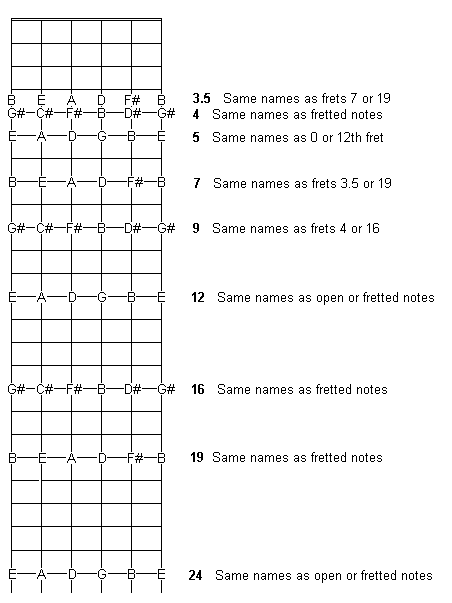
This tutorial was inspired by a question that I was recently asked via the AllExperts website.
When a guitar string vibrates, it moves in a regular motion between two fixed points; the bridge and the fret (or nut). It's kind of hard to see a moving string, because it vibrates so fast, but try holding the guitar in front of a TV screen (while the TV's on, obviously). You get a strobe effect that makes the motion much easier to see - something like this:

This vibrating string is known as a 'fundamental'. Now try lightly touching the string at the 12th fret. Don't actually press the string down against the fret wire, just tap the string lightly. You should hear a note an octave above the open note, and the strings pattern of vibration should look like this:

This is what's known as a 'natural harmonic'. It's an open string which has been forced to vibrate in a different way, so that it gives a different pitch. In terms of the physics behind it all, what we've done is half the wavelength, which doubles the pitch (i.e. raises it by an octave).
Now try playing an open string and lightly touching it at around the 7th fret. The 7th fret is a third of the way up the guitar neck from the nut, and it gives the string a vibration pattern like this:
This gives a note a perfect-fifth-plus-an-octave above the open string.
| As you might have guessed by now, we can induce a harmonic from an open string by touching it at a point which is part of an equal division of the string's length. This point is called a node point, and this diagram below shows where natural harmonics occur on the guitar fingerboard. |  |
Natural harmonics are useful to have in your armoury. Once you're familiar with natural harmonics, then you'll find artificial harmonics much easier to get to grips with.
A natural harmonic occurs when an open string is forced to play a sound other than the fundamental. An artificial harmonic is similar, but it occurs when a harmonic is induced from a fretted string. For example, if you fretted the E string at the first fret and played a harmonic at the 13th fret, you would hear a harmonic F.
Playing artifical harmonics requires you to touch the string lightly just as you pick it. The most common way of doing this is to pick the string at the desired node point, holding the pick so that only the very point is protruding below the flesh of your thumb. Immediately as you pick the string, allow the flesh of your thumb to touch the string, thus inducing a harmonic.
An alternative is to 'pinch' the string - pick the string normally, but touch the string at the node point using a right hand finger. This is a little trickier to do, and calls for a little more co-ordination in your right hand.
Take time to get familiar with the theory and to practise the techniques needed to play harmonics. Thay are useful things, and have fairly diverse applications. Playing harmonics on arpeggios can give a really nice 'ringing' effect - great with a clean/chorus-y sound. Artificial harmonics also occur quite a lot in rock soloing - they're a great way of adding a dramatic 'screaming' note without having to totally re-adjust your left-hand positioning to get further up the neck.
Have fun.
How useful did you find this tutorial?
| Product/Info... | PhatPhish Application | | | Product Help | | | GUPPY - PhatPhish for the web | | | About The Author |
|---|
| Get Stuff... | Download PhatPhish | | | Mechandise | | | Blank Stave And Tab Sheets | | | Tutorials |
|---|
| Do Stuff... | Register | | | Feedback | | | Links | | | Donate | | | Ask A Question |
|---|
| Social Media... | YouTube | | | | |
|---|
| Promote... | Spread The Word | | | Posters/Flyers |
|---|
| Play... | PhatPhish Picks - Boutique Plectrums |
|---|
| ©2002-2022, Dave Dixon / CyberFlotsam http://www.cyberflotsam.com |